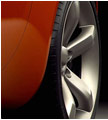For Release: August 7, 2001
Contact(s):
Scott Fosgard, GM Technology
Phone: (810) 986-0623 ; (810) 899-2582 (cell)
Email:
scott.fosgard@gm.com
Bob Campbell, Hass Associates
Phone: (248) 528-0283; (248) 895-0791 (cell)
Email:
rcampbell@ha-i.com
Traverse City, Mich. - General Motors' pioneering fuel cell program is rapidly paving the way for a time when fuel cells power not only automobiles, but homes and businesses. And this vision may be closer than you think.
GM, a global innovation leader, has added a stationary power unit capable of powering a house to its impressive list of research and development inventions.
Larry Burns, GM vice president for research and development, and planning, drove up to the unit today in a Chevrolet S-10 pickup truck powered by the world's first gasoline reformer at the University of Michigan Automotive Briefing Seminar.
"Last year, when I was here to announce that GM was revving up the fuel cell race, the gasoline fuel processor was so large I couldn't bring it to show you," Burns said. "Today, I am happy to report that the fuel processor is significantly smaller than it was a year ago.
"And as an added bonus, we've produced a stationary power unit, which provides a new, innovative way to supply electricity to homes and businesses."
By significantly increasing the power output of its fuel cell components while dramatically reducing their size, GM is leading the way on a new frontier, Burns told reporters gathered at the annual automotive management seminar.
The prototype stationary unit - capable of running on natural gas, methane or gasoline - incorporates the same fuel processor and stack technology used on experimental vehicles to convert gasoline into a high-quality stream of hydrogen that powers the fuel cell.
"In terms of power, our technology is easily scaled up or down," Burns added. "A unit could be built to power my house, an entire subdivision, the White House or even a manufacturing plant."
A fuel cell used as a stationary power source could help meet the growing demand for electricity with a unit that will be only about the size of a refrigerator. It's even possible that stationary units could be on the market before fuel cell-powered vehicles, Burns said.
"In addition to being an exciting business opportunity, it would accelerate our learning with respect to increasing consumers' familiarity with fuel cell technology, and understanding its durability and manufacturability," Burns said.
The stationary application of fuel cells and increased power of the automotive fuel cell, when combined, is one more step for GM in its ongoing effort to apply its technological know-how to global energy and environmental challenges.
"At this point, we have made no business decisions regarding the application of our technology to stationary power, but we have been contacted by several companies regarding the possibility of working together to commercialize stationary, distributed generator units," said Burns.
GM revealed the new technologies at the four-day Management Briefing Seminars, co-hosted by the Center for Automotive Research of the Environmental Research Institute of Michigan, the Center for Professional Development of the University of Michigan College of Engineering and the U-M Office for the Study of Automotive Transportation.
"This conference is about where the automotive industry is headed," said Burns. "We thought this was the perfect opportunity for us, not just to talk about where GM is going, but to show you. GM remains committed to being the first company to sell 1 million fuel cell vehicles."
General Motors Corporation (NYSE: GM), the world's largest vehicle manufacturer, designs, builds and markets cars and trucks worldwide. In 2000, GM earned $5 billion on sales of $183.3 billion. It employs about 372,000 people globally.




